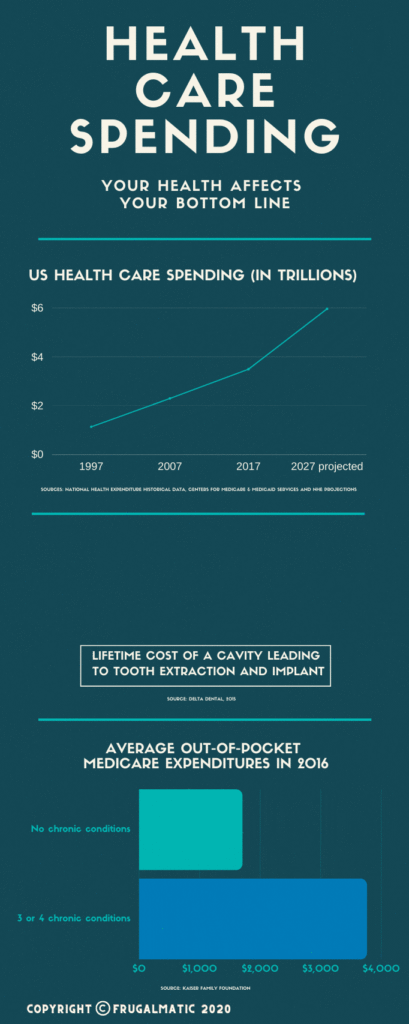This post was last updated on July 13th, 2022 at 09:49 am
If you’re saving for retirement, you probably don’t intend to touch your accounts for a long time, perhaps decades. You have the discipline and vision to plan for the future. Are you thinking about your health in the same way? If not, it’s time to make your health part of your retirement planning.
Nobody knows the future, but it’s reasonable to assume health-related decisions you make today will affect you around the time you start to tap your retirement funds. At Frugalmatic, we believe believe steps taken today to maintain our health will have a compounding effect similar to a financial investment, ultimately yielding thousands of dollars in savings years from now. You cannot, in my view, consider yourself a frugal person but then make poor health decisions likely to require expensive medical treatments years later.
In the Frugalmatic world, there’s no such thing as a “frugal smoker” or “frugal fast food.” These are oxymorons.
Medical problems connected to higher costs
It’s impossible to say whether any one person will experience serious medical problems as they age or how much these problems will cost to treat. However, statistics show people in poor health generally end up spending more out-of-pocket expenses as they get older. According to the Kaiser Family Foundation, a Medicare beneficiary with zero chronic health conditions spent in 2016, on average, $2,057 less in out-of-pocket health care expenses than a Medicare beneficiary with three or four chronic conditions.
Keep in mind, that’s just an average. Certain medical problems treated with specialty drugs can cost Medicare Part D participants thousands of dollars in out-of-pocket expenses.
And don’t forget the importance of maintaining good oral health. A Delta Dental study found the lifetime costs of a decayed tooth ran as high as $3,343. Every time you floss and brush your teeth, it’s like making a small contribution to your retirement. You’ll hopefully avoid costly dental work, such as root canals and implants, later in life.
Dental spending is expected to increase at a 4.8% annual rate through 2027, while health care spending is expected to grow 5.5% annually through 2027. You can bet health care costs today, as ludicrously high as they are, will seem like a bargain 10 to 20 years from now.


Invest in your health as an inflation hedge
When you’re taking care of your health, you’re minimizing the destructive effects of inflation. If you’re still years from retirement, it’s not the cost of managing hypertension today that’s the problem—it’s the cost 20 years from now.
When financial professionals give investing advice, they often frown on young people buying lots of fixed-income assets, such as bonds, because inflation can destroy their value. These professionals often steer young people to assets designed to act as inflation hedges. Taking care of your health is investing in an inflation hedge, an extremely powerful hedge given health care spending consistently outpaces the U.S. core inflation rate.
Not only are you hedging against inflation by prioritizing your health, you are hedging against the breakdown of the U.S. health system. It’s no secret Medicare is insufficiently funded. Recent projections indicate its hospital insurance trust fund won’t be able to pay all benefits starting in 2024. It will probably take a crisis for politicians to address this problem, and by then it might be too late. Younger generations should assume this program will resemble nothing like the program that has served their parents and grandparents for so many years.
I’m not trying to be an alarmist here. I’m being practical, just as many people are practical when putting money in a 401K or IRA for their retirement. Investing in your health is just as important as saving money for the future.
That’s one reason why Frugalmatic emphasizes the importance of staying physically fit. To be clear, I’m not talking about getting in shape to run a 5K (though I’m not saying that’s a bad idea). I’m talking about simply having an active lifestyle. If you can avoid being sedentary, you’ll be in a better position to prevent certain chronic conditions, such as diabetes and hypertension. Of course, you can be a marathon runner and still have diabetes or hypertension. Genetics play a role, and diet must be considered, too. There’s no guarantee that being physically active will prevent certain diseases. At the same time, there’s also no guarantee your investments won’t disappear in a catastrophic financial collapse. All you can do is try to stack the odds in your favor. In terms of your health, you want to bet on a lifestyle least likely to trigger chronic conditions as you age.
Poor health can undermine your retirement goals
Ideally, you are maximizing your retirement investments while minimizing your health care costs. If you enter those later years in good financial shape but poor health, you’ll probably negate some of those efforts you made years ago to save money. All that discipline you showed by setting aside some of your paycheck for retirement can be undermined by failing to pay attention to your health.
If you’re conscientious about saving money for retirement, it makes sense to be conscientious about saving your health. If you have one without the other, you’re only half-prepared for retirement. Disregarding your health is like gambling with your retirement investment portfolio, putting all your money in a single stock, for instance. Maybe you’ll turn out OK, but there’s a good chance you’ll regret not diversifying.
Diversify by staying active throughout your day
You might be saying: “This is all good advice, but how do I stay fit year after year?” Perhaps you even have a gym membership or recently bought a new piece of exercise equipment. Maybe you start every year with a resolution of getting in better shape. But for whatever reason, you struggle to reach your fitness goals. The frugalmatic philosophy is to embed physical activity into your daily routine so that you’ll force yourself to stay active. The key is to link fitness to life’s responsibilities so that you’re being active while getting stuff done.
Take the work commute, for example. There’s almost always a way to build some activity into your commute. Biking or walking to work is ideal. But if you can’t do that, try parking several blocks from where you work. Or, if you can’t do that, walk around the block a couple times before heading to work. Then walk around the block at work before heading home.
You might say, “I work from home. What are my options?” In this case, you can simulate a work commute. Even if that means hopping on a stationary exercise bike and simulating the bike ride itself. Use both the start and end of your work day as triggers to get some exercise.
Don’t like riding bikes? No problem. Shoot hoops in the driveway for 15 minutes. No basketball hoop? Turn on an exercise video. There’s a way to do it. You just need to commit.
Beware the effects of labor-saving technologies
Our digital economy is constantly coming up with new ways to encourage us to sit more and move less. In this world, you have to be intentional about adding movement to your day. Resist the temptation to use technology to minimize your physical activity. For example, don’t have groceries delivered to your home if you can help it. Walk the store aisles. If you insist on deliveries, however, walk three or four blocks after the delivery to compensate for losing the physical activity.
Plan ambitious home projects, including in the yard. Trade that leaf blower for a rake or broom, for example. Do you wish you had a riding lawnmower, or maybe one of those new robotic mowers? Reconsider it. You can get a solid cardio workout with a push mower.
Do the car tires need air? Hold off using an air compressor and use a bike pump to give your arms a mini-workout.
Be mindful of your routine so you can identify opportunities to move your body more frequently. Our consumer culture isn’t going to identify these opportunities for you. Marketers are too busy selling you products to keep you in your chair: smartphones, video game systems, new TV streaming services, etc. Heck, you don’t even have to wash out your garbage bins anymore. There are services that will come and do it for you.
Don’t count on others to draw attention to your health
Be physically active not only to feel better. Be active for the sake of retirement planning. If this sounds weird and like something you’ve never heard before, that might be because financial companies earn money by investing your money. They don’t earn anything by you riding your bike to work. That’s why, when most people talk about retirement planning, they usually only speak about dollars and cents. They don’t earn commissions, fees or interest on the steps you take to improve your health.
Also, keep in mind pharmaceutical companies and the health care industry benefit from people getting sick. It might sound cynical, but the reality is that these companies make money by treating your ailments, not by you preventing them.
At the end of the day, the person that benefits most from your healthy habits is you.
Go ahead and share this article with others. Let them know there’s more to preparing for retirement than contributing to a retirement account. Commit to making your health part of your retirement planning.

